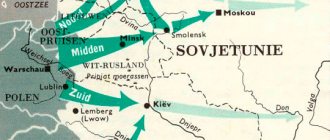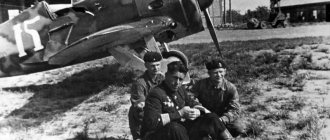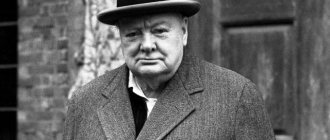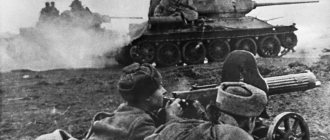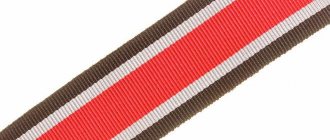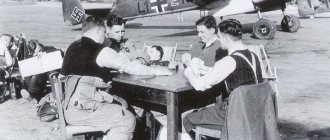1935–1945 Ground branch of the German armed forces
| This article requires additional links for verification . |
| German army | |
| Heer | |
| German army helmet sticker | |
| Active | 1935–1945 |
| Dissolved | 1946 |
| A country | Germany |
| Loyalty | Adolf Gitler |
| Type | Ground forces |
| Size | Total served: 13,600,000 [1] |
| Part | Wehrmacht |
| Headquarters | Maybach I, Wünsdorf |
| Equipment | List of army equipment |
| Engagements | Spanish Civil War World War II |
| Commanders | |
| Supreme Commander | Adolf Gitler |
| Commander-in-Chief of the Army | View list |
| Chief of the General Staff | View list |
| Marks of Excellence | |
| Ranks and insignia | Army ranks and insignia |
| Object flag | |
German army
(German: Heer, German: [heːɐ̯] ( listen); lit. "Army") was the ground forces component
of the Wehrmacht
, [a] regular armed force of Germany, from 1935 until it ceased to exist in 1945 and was then formally dissolved in August 1946. [2] During World War II, a total of approximately 13.6 million soldiers served in the German army. The army personnel consisted of volunteers and conscripts.
Just 17 months after Adolf Hitler announced the German rearmament program in 1935, the army had achieved its planned target of 36 divisions. In the fall of 1937, two more corps were formed. In 1938, after the Anschluss in March, four additional corps were formed to include five divisions of the Austrian Army. [3] During its period of expansion under Hitler, the German army continued to develop concepts first used during World War I, combining ground and air assets into a combined arms force. Combined with operational tactics such as encirclement and "battle of annihilation", the German military managed to quickly achieve victory in the first two years of World War II, a new style of warfare described as blitzkrieg
(blitzkrieg
)
for its speed and destructive power. [4]
The German Army waged a war of extermination on the Eastern Front and was responsible for many war crimes along with the Waffen and Allgemeine SS.
Structure [edit]
Adolf Hitler with Wilhelm Keitel, Friedrich Paulus and Walter von Brauchitsch, October 1941
Supreme Command of the Army
(OKH) was Nazi Germany's Army High Command from 1936 to 1945. In theory, the
Wehrmacht High Command
(OKW) served as the military general staff for the Reich's armed forces, coordinating
Wehrmacht
(
Heer
,
Kriegsmarine
, and
Luftwaffe
) operations.
In practice, the OKW was subordinate to Hitler's personal military staff, translating his ideas into military plans and orders and transmitting them to the three services. [5] However, as World War II continued, the OKW found itself exercising increasing direct command of military units, especially in the west. This meant that by 1942 the OKW was the de facto
command of the forces in the Western Theater, while the Army High Command (OKH) remained the same on the Eastern Front. [6]
Abwehr
was a military intelligence organization from 1921 to 1944. The term
Abwehr
(German for "defense", here in reference to counterintelligence) was created immediately after World War I as an ostensible concession to the Allied requirement that Germany's intelligence activities be for defensive purposes only.
After 4 February 1938, the name of the Abwehr
was changed to the Overseas Department/Office for the Protection of the High Command of the Armed Forces (
Amt Ausland/Abwehr im Oberkommando der Wehrmacht
).
Germany used a system of military districts (German: Wehrkreis
) to relieve field commanders of as much administrative work as possible and ensure a regular flow of trained recruits and supplies for the field troops.
The method adopted by the OKW was to separate the field army (OKH) from the Home Command ( Heimatkriegsgebiet
) and place responsibility for training, conscription, supplies and equipment in the Home Command.
Organization of field forces[edit]
German soldiers in Greece, April 1941
The German army was mainly structured into army
(
Heeresgruppen
), consisting of several armies that were redeployed, reorganized or renamed during the course of the war. The forces of the allied states, as well as units consisting of non-Germans, were also assigned to the German units.
For Operation Barbarossa in 1941, army forces were distributed across three strategic campaign groups:
- Army Group North with Leningrad as the campaign objective
- Army Group Center with Smolensk as the campaign objective
- Army Group South with Kiev as the campaign objective
Below the army group, the forces included field armies - tank
groups that later became army-level formations, corps and divisions themselves.
The Army used the German term Kampfgruppe
, which means battle group in English. These temporary fighting groups ranged from corps, such as the Kempf Army Detachment, to commands consisting of companies or even platoons. They were named after their commanders.
Select branches of service[edit]
- Panzerjäger
(Anti-tank forces) - Panzergrenadier
(armored infantry forces) - Panzerwaffe
(armored forces) - Army propaganda troops
- Experimental team Kummersdorf
- Foreign armies of the East
- Feldgendarmerie
(Military Police) - Gebirgsjäger
(Mountain troops) - Geheime Feldpolizei
(Secret Field Police) - Prussian Military Academy
- Kriegsschule
(War College)
Commanders of army groups
| Awards | Full name | Portrait | Rank and position on the eve of the war | Army group and command dates | Battles and operations carried out as commander | Rank and position at the end of the war (for those killed - the circumstances of death) | Etc. |
| Arnim, Hans-Jürgen von (German: Hans-Jürgen von Arnim) | (1889—1962) | Major General, Special Assignments Officer at the OKH | "Africa": 03/09/1943—05/13/1943 | Tunisian campaign | Colonel General, prisoner of war (capitulated 05/13/1943 in Tunisia) | [4] | |
| Balck, Hermann (German: Hermann Balck) | (1893—1982) | Lieutenant Colonel, Motorized Troops Inspectorate Officer | «»: 21.09.1944—23.12.1944 | fighting in Alsace | General of Tank Forces, Commander of the 6th Army | [5] | |
| Blaskowitz, Johannes (German: Johannes Blaskowitz) | (1883—1948) | General of Infantry, Commander of the 8th Army | «»: 19.05.1944—21.09.1944; 23.12.1944—28.01.1945 «»: 28.01.1945—07.04.1945 | fighting in Alsace and Holland | Colonel General, Commander-in-Chief of the Wehrmacht forces in Holland | [6] | |
| Bock, Fedor von (German: Fedor von Bock) | (1880—1945) | Colonel General, Commander of Army Group North | "North": 08/26/1939—10/05/1939 "": 10/05/1939—06/21/1941 "Center": 06/21/1941—12/18/1941 "": 01/18/1942—07/17/1942 | Polish Campaign (1939) French Campaign (1940) Operation Barbarossa Battle of Moscow (1941-1942) Kharkov Operation (1942) | Field Marshal General, in the OKW reserve (died on 05/04/1945 as a result of an Allied air raid) | [7] | |
| Busch, Ernst (German: Ernst Busch) | (1885—1945) | General of Infantry, Commander of the 8th Army Corps | "Center": 11/04/1943—07/28/1944 | Belarusian operation (1944) | Field Marshal General, Commander of Wehrmacht forces in the North-West | [8] | |
| Weiss, Walter (German: Walter Weiss) | (1890—1967) | Colonel, Chief of Staff of the 1st Army Corps | "North": 03/11/1945—04/08/1945 | East Prussian operation (1945) | Colonel General, OKW reserve | [9] | |
| Weichs, Maximilian von (German: Maximilian von Weichs) | (1881—1954) | General of Cavalry, Commander of the 13th Army Corps | «»: 15.07.1942—14.02.1943 «»: 20.08.1943—29.03.1945 | Battle of Stalingrad Ostrogozh-Rossoshan operation Belgrade operation Budapest operation | Field Marshal General, OKW reserve | [10] | |
| Wöhler, Otto (German: Otto Wöhler) | (1894—1987) | Colonel, Chief of the Operations Department of the 14th Army Headquarters | «»: 22.12.1944—25.03.1945 | Budapest operation Balaton operation | general of infantry, OKW reserve | [11] | |
| Witzleben, Erwin von (German: Job-Wilhelm Georg "Erwin" von Witzleben) | (1881—1944) | General of Infantry, Commander of the 1st Army | «»: 26.10.1940—04.02.1942 | Carrying out occupation functions in France, Belgium, Holland | Field Marshal General, in the OKW reserve (executed on 08/09/1944 as one of the organizers of the July Plot) | [12] | |
| Himmler, Heinrich (German: Heinrich Himmler) | (1900—1945) | Reichsführer SS | "Upper Rhine": 12/07/1944—01/29/1945 "Vistula": 01/29/1945—03/21/1945[sn 1][13] | Alsace-Lorraine operation Colmar operation East Pomeranian operation | 04/28/1945, by order of Hitler, removed from all government posts for attempting to conduct separate negotiations with the allies | [14] | |
| Hitler, Adolf (German: Adolf Hitler) | (1889—1945) | Fuhrer and Reich Chancellor of Germany | "": 09/10/1942—11/21/1942[sn 2][15] | Battle for the Caucasus (1942-1943) | 04/30/1945 committed suicide in his bunker, surrounded by Soviet troops | [16] | |
| Kesselring, Albert (German: Albert Kesselring) | (1885—1960) | General of Aviation, Commander of the 1st Air Fleet | «»: 15.11.1943—23.10.1944; 14.01.1945—10.03.1945 «»: 11.03.1945—06.05.1945 | Italian campaign (1943-1945) Central European operation | Field Marshal, Commander of Army Group D | [17] | |
| Kleist, Ewald von (German: Ewald von Kleist) | (1881—1954) | general of cavalry, commander of the 22nd motorized corps | «»: 21.11.1942—31.03.1944 | Battle for the Caucasus (1942-1943) Lower Dnieper operation | Field Marshal General, OKW reserve | [18] | |
| Kluge, Hans Gunther von (German: Günther von Kluge) | (1882—1944) | General of Artillery, Commander of the 4th Army | "Center": 12/19/1941—10/28/1943 "": 07/02/1944—08/15/1944 | Battle of Moscow Battle of Rzhev (1942–1943) Battle of Kursk Chernigov-Poltava operation Operation Cobra Falaise operation | Field Marshal General, 08/18/1944 was removed from command of Army Group D, after which he committed suicide | [19] | |
| Küchler, Georg von (German: Georg von Küchler) | (1881—1968) | General of Artillery, Commander of the 3rd Army | "North": 01/17/1942—01/31/1944 | Battle of Leningrad Leningrad-Novgorod operation | Field Marshal General, OKW reserve | [20] | |
| Leeb, Wilhelm von (German: Wilhelm von Leeb) | (1876—1956) | Colonel General, Commander of Army Group C | "": 08.26.1939—06.20.1941 "North": 06.20.1941—01.17.1942 | French campaign Operation Barbarossa Battle of Leningrad | Field Marshal General, OKW reserve | [21] | |
| Löhr, Alexander (German: Alexander Löhr) | (1885—1947) | General of Aviation, Commander of the 4th Air Fleet | «»: 28.12.1942—08.05.1945 | Belgrade operation | Colonel General, Commander of Army Group E | [22] | |
| Lindemann, Georg (German: Georg Lindemann) | (1884—1963) | Lieutenant General, Commander of the 36th Infantry Division | "North": 03/01/1944—07/05/1944 | local battles in the northwestern direction of the Eastern Front | Colonel General, Commander of the Wehrmacht forces in Denmark | [23] | |
| List, Wilhelm (German: Wilhelm List) | (1880—1971) | Colonel General, Commander of the 14th Army | «»: 15.07.1942—09.09.1942 | Battle for the Caucasus (1942-1943) | Field Marshal General, OKW reserve | [24] | |
| Manstein, Erich von (German: Erich von Manstein) | (1887—1973) | Lieutenant General, Chief of Staff of Army Group South | “Don”: 11/21/1942—02/13/1943 “”: 02/13/1943—04/01/1944 | Battle of Stalingrad Third Battle of Kharkov Battle of Kursk Battle of the Dnieper Dnieper-Carpathian Operation | Field Marshal General, OKW reserve | [25] | |
| Model, Walter (German: Walter Model) | (1891—1945) | Major General, Chief of Staff of the 4th Army Corps | "North": 01/31/1944—04/01/1944 "": 04/01/1944—04/05/1944 "Northern Ukraine": 04/05/1944—07/28/1944 "Center": 07/28/1944—08/18/1944 "": 08/18/19 44 —04/22/1945 | Dnieper-Carpathian operation Belarusian operation (1944) Falaise operation Dutch operation (1944) Ardennes operation (1945) Meuse-Rhine operation Ruhr operation | Field Marshal, committed suicide in the Ruhr Pocket | [26] | |
| Reinhardt, Georg Hans (German: Georg-Hans Reinhardt) | (1887—1953) | Major General, Commander of the 4th Tank Division | "Center": 08/16/1944—01/27/1945 | Belarusian operation (1944) Vistula-Oder operation East Prussian operation (1945) | Colonel General, OKW reserve | [27] | |
| Reichenau, Walter von (German: Walter von Reichenau) | (1884—1942) | General of Artillery, Commander of the 10th Army | «»: 01.12.1941—15.01.1942 | Rostov operation (1941) | Field Marshal, died on January 17, 1942 from cardiac arrest and/or from a traumatic brain injury he received during an air flight[sn 3][28] | [29] | |
| Rendulic, Lothar (German: Lothar Rendulic) | (1887—1971) | Colonel, Chief of Staff of the 17th Army Corps | "North": 01/15/1945—03/10/1945 "Courland": 03/12/1945—03/25/1945 "": 03/25/1945—05/08/1945 | East Prussian operation (1945) Courland Pocket Vienna operation | Colonel General, Commander of Army Group South | [30] | |
| Rommel, Erwin (German: Erwin Rommel) | (1891—1944) | Colonel, Commandant of the Fuhrer's Headquarters | "Africa": 02/22/1943—03/09/1943 "": 07/19/1943—07/17/1944 | Tunisian Campaign Normandy Operation | Field Marshal General, 10/14/1944, under duress from Hitler’s chief adjutant, committed suicide due to involvement in the July Plot[31] | [32] | |
| Rundstedt, Gerd von (German: Gerd von Rundstedt) | (1875—1953) | Colonel General, "" | «»: 26.08.1939—08.10.1939; 21.06.1941—01.12.1941 «»: 26.10.1939—10.10.1940 «»: 15.03.1942—02.07.1944; 15.08.1944—11.03.1945 | Polish campaign French campaign Operation Barbarossa Rostov operation (1941) Normandy operation Bulge operation (1945) | Field Marshal General, prisoner of war (captured on 05/01/1945 on his own estate, where he lived after his resignation in March 1945) | [33] | |
| Vietinghof, Heinrich von (German: Heinrich von Vietinghoff) | (1887—1952) | Major General, Commander of the 5th Tank Division | "": 10/24/1944—01/13/1945; 03/11/1945—05/02/1945 “Courland”: 01/15/1945—03/10/1945 | Italian campaign (1943-1945) Courland Pocket Northern Italian operation | Colonel General, Commander of Army Group C | [34] | |
| Friessner, Johannes (German: Johannes Frießner) | (1892—1971) | Colonel, combat training instructor, Army Reserve | “North”: 07/03/1944—07/25/1944 “Southern Ukraine”: 07/25/1944—09/25/1944 “”: 09/25/1944—12/22/1944 | Iasi-Chisinau operation Bucharest-Arad operation Debrecen operation | Colonel General, OKW reserve | [35] | |
| Harpe, Joseph (German: Josef Harpe) | (1887—1968) | Colonel, commander of the 1st Tank Brigade | “Northern Ukraine”: 07/28/1944—09/25/1944 “”: 09/25/1944—01/17/1945 | East Carpathian operation Vistula-Oder operation | Colonel General, prisoner of war (capitulated 04/01/1945 in the Ruhr Pocket) | [36] | |
| Hausser, Paul (German: Paul Hausser) | (1880—1972) | Brigadeführer and Major General of the SS Troops, Inspector of the SS Troops | «»: 28.01.1945—04.04.1945 | Central European Operation | Oberstgruppenführer and Colonel General of the SS troops, in the OKW reserve | [37] | |
| Heinrici, Gotthard (German: Gotthard Heinrici) | (1886—1971) | Lieutenant General, Commander of the 16th Infantry Division | "Wistula": 03/01/1945—04/28/1945 | Berlin operation | Colonel General; 04/28/1945 removed from command for an unauthorized order to retreat | [38] | |
| Hilpert, Carl (German: Carl Hilpert) | (1888—1947) | Major General, Chief of Staff of the 9th Army Corps | "Courland": 03/25/1945—05/09/1945 | Courland Cauldron | Colonel General, Commander of Army Group Courland | [39] | |
| Schörner, Ferdinand (German: Ferdinand Schörner) | (1892—1973) | Colonel, commander of the 98th Mountain Jaeger Regiment | “Southern Ukraine”: 04/07/1944—07/07/1944 “North”: 07/25/1944—01/17/1945 “”: 01/17/1945—01/25/1945 “Center”: 01/25/1945—05/09/1945 | Crimean operation (1944) Belarusian operation (1944) Baltic operation (1944) West Carpathian operation Lower Silesian offensive operation Upper Silesian offensive operation Prague operation | Field Marshal General, from April 30, 1945 - Commander-in-Chief of the German Ground Forces (did not actually take office) | [40] | |
| Student, Kurt (German: Kurt Student) | (1890—1978) | Major General, Commander of the 7th Airborne Division | «»: 09.11.1944—25.01.1945 | fighting in Holland | Colonel General; 04/30/1945 appointed commander of Army Group Vistula (did not actually take office) | [41] | |
| Schulz, Friedrich (German: Friedrich Schulz) | (1897—1976) | Lieutenant Colonel, OKH Staff Officer | «»: 02.04.1945—05.05.1945 | Central European Operation | general of infantry, commander of Army Group G. | [42] |
Doctrine and tactics[edit]
| In this section do not cite any sources . |
German operational doctrine emphasized wide sweeps and lateral movements designed to destroy enemy forces as quickly as possible. This approach, called blitzkrieg
, was an operational doctrine that contributed to the success of the offensive in Poland and France.
Many historians believe that blitzkrieg
has its origins in the precepts developed by Fuller, Liddell-Hart and von Seeckt, and even has ancient prototypes practiced by Alexander, Genghis Khan and Napoleon.
[7] [8] Recent studies of the Battle of France also suggest that the actions of either Rommel or Guderian or both (both contributed to the theoretical development and early practice of what later became Blitzkrieg
before World War II) [9] [ 10], ignoring the orders of superiors who had never foreseen such spectacular successes and thus prepared much more prudent plans, were combined into a focused doctrine and created the first archetype of the
Blitzkrieg
, which then acquired a fearsome reputation that dominated the minds of the Allied leaders.
[11] [12] [13] Thus, "Blitzkrieg"
was recognized after the fact, and while it was adopted by
the Wehrmacht
, it never became an official doctrine and was not used to its full extent because only a small part of
the Wehrmacht
was trained in it. and key leaders at the highest levels either focused only on certain aspects or did not even understand it. [14] [15] [16]
Max Visser argues that the German Army was focused on achieving high combat performance rather than high organizational efficiency (like the US Army). He emphasized adaptability, flexibility and decentralized decision making. Officers and NCOs were selected on the basis of character and trained for decisive combat leadership. Good combat performance was rewarded. Visser argues that this allowed the German army to achieve superior combat performance compared to more traditional organizational doctrine such as the American one; although this would eventually be offset by the Allies' superior numerical and material advantage, Visser argues that it allowed the German army to resist much longer than if it had not adopted this method of organization and doctrine. [17] Peter Turchin reports that research by American Colonel Trevor Dupuy showed that Germany's combat effectiveness was higher than that of the British and American armies - while a combat effectiveness of 1 was assigned to the British, the Americans had a combat effectiveness of 1.1, and the Germans - more than 10%. 1.45. This would mean that British forces would need to commit 45% more troops (or more heavily arm existing troops in the same proportion) to have an equal chance of winning the battle, while the Americans would need to commit 30% more to have equal chances. . [18]
Tactics [edit]
Soldiers of the Grossdeutschland Division during Operation Barbarossa, 1941.
The military power of the German army was controlled through mission-based tactics ( Auftragstaktik
) (rather than detailed tactics based on orders), and almost notorious discipline. Once an operation, offensive or defensive, had begun, speed of reaction to changing circumstances was considered more important than careful planning and coordination of new plans.
In public opinion, the German military was and is sometimes seen as a high-tech army, as new technologies that were introduced before and during World War II influenced the development of tactical doctrine. These technologies were used by Nazi propaganda, but were often only available in small quantities or late in the war as overall supplies of raw materials and weapons became low. For example, lacking sufficient vehicles to equip more than a small portion of their army, the Germans chose to concentrate their available equipment into a small number of divisions, which were to be fully motorized. The remaining divisions still used horses to pull artillery, other heavy equipment, and supply wagons, with men traveling on foot or riding bicycles. At the peak of motorization, only 20 percent of all units were fully motorized. [ citation needed
]The small German contingent fighting in North Africa was entirely motorized (relying on horses in the desert was almost impossible due to the need to carry large quantities of water and feed), but the much larger force that invaded the Soviet Union in June 1941 , numbered only about 150,000 trucks and about 625,000 horses (water was plentiful, and for many months of the year horses were able to forage, reducing pressure on the supply chain).
However, the production of new cars in Germany, even taking into account the exploitation of factories in the occupied countries, could not cope with the heavy losses of cars in the winter of 1941–1942. From June 1941 to the end of February 1942, German forces in the Soviet Union lost about 75 people, 000 trucks to mechanical wear and battle damage - about half as many as at the beginning of the campaign. Most were lost during the retreat in the face of the Soviet counter-offensive from December 1941 to February 1942. Another significant loss was suffered during the defeat of the Soviet forces by the German 6th Army at Stalingrad in the winter of 1942–1943. These losses in men and equipment meant that motorized troops at some points in the war constituted no more than 10% of the total Heer
.
In offensive operations, infantry formations were used to make more or less simultaneous attacks over a large part of the front in order to keep enemy forces ahead of them and attract attention, while mobile formations were concentrated to attack only narrow sections of the front. front, breaking through to the rear of the enemy and surrounding him. Some infantry formations followed the path of the mobile formations, clearing, widening the corridor created by the breakthrough attack and strengthening the ring surrounding the abandoned enemy formations, and then gradually destroying them with concentric attacks. One of the most significant problems hampering the German advance, and initially worrying the senior command, was the gap between the fast-moving "fast formations" and the following infantry, since infantry was seen as essential to protecting the flanks and rear of the "fast formations" and allowing supply columns to escape from fuel, fuel and ammunition on them.
In defensive operations, infantry formations were deployed along the front to hold the main line of defense, and mobile formations were concentrated in a small number of points, from where they launched targeted counterattacks against enemy forces that had broken through the infantry defense line. At El Alamein in the fall of 1942, fuel shortages forced the German commander, Field Marshal Erwin Rommel, to disperse his armored personnel carriers along the front in battalion-sized concentrations to shorten the travel distance to each sector rather than keep them in one place. In 1944, Rommel argued that in the face of overwhelming Anglo-American air power, the tactic of using concentrated "fast formations" was no longer possible because they could no longer move fast enough to reach threatened areas due to the expected denial of all routes by Allied fighter-bombers. Therefore, he proposed dispersing these units along the front immediately behind the infantry. His commanders and colleagues, less experienced in the effects of Allied airpower, strongly disagreed with his proposal, arguing that it would violate the basic principle of concentration of forces.
Notes
Comments
- Himmler exercised nominal command. The current leadership was carried out by the chiefs of staff of the army groups, SS Gruppenführer Werner Ostendorf and Lieutenant General Walter Wenck.
- Hitler exercised nominal command, being thousands of kilometers from the front line. Current leadership was entrusted to the Chief of Staff of the Army Group, Lieutenant General Hans von Greifenberg.
- Reichenau, who had suffered a heart attack the day before, was transported by plane to Germany. During the flight, the plane made an emergency landing, as a result of which the field marshal received a serious head injury. He was delivered to his destination already dead.
Sources
- Mitcham, 1998, p. eleven.
- Barnett, 1999, p. 27.
- Mitcham, 1998, p. 8.
- Zalessky, 2008, p. 16.
- Zalessky, 2008, p. 21-22.
- Zalessky, 2008, p. 27.
- Zalessky, 2008, p. 29-30.
- Zalessky, 2008, p. 36.
- Zalessky, 2008, p. 40-41.
- Zalessky, 2008, p. 41-42.
- Zalessky, 2008, p. 42.
- Zalessky, 2008, p. 49-50.
- Guderian, 1998, p. 556-570.
- Zalessky, 2002, p. 202-207.
- Mitcham, 1998, p. 281.
- Zalessky, 2002, p. 209-225.
- Zalessky, 2008, p. 109-110.
- Zalessky, 2008, p. 112.
- Zalessky, 2008, p. 113.
- Zalessky, 2008, p. 119-120.
- Zalessky, 2008, p. 123-124.
- Zalessky, 2008, p. 125.
- Zalessky, 2008, p. 126.
- Zalessky, 2008, p. 126-127.
- Zalessky, 2008, p. 131-133.
- Zalessky, 2008, p. 137.
- Zalessky, 2008, p. 164.
- Mitcham, 1998, p. 169.
- Zalessky, 2008, p. 164-165.
- Zalessky, 2008, p. 167-168.
- Mitcham, 1998, p. 263.
- Zalessky, 2008, p. 169-170.
- Zalessky, 2008, p. 171-172.
- Zalessky, 2008, p. 214.
- Zalessky, 2008, p. 217.
- Zalessky, 2008, p. 64.
- Zalessky, 2002, p. 674-676.
- Zalessky, 2008, p. 222-223.
- Zalessky, 2008, p. 69.
- Zalessky, 2008, p. 238-239.
- Zalessky, 2008, p. 574.
- Zalessky, 2008, p. 254.
Campaigns[edit]
The infantry remained dismounted throughout the war; artillery also remained predominantly mounted. The motorized formations received much attention in the world press in the opening years of the war, and were cited as the main reason for the success of the German invasions of Poland (September 1939), Denmark and Norway (1940), Belgium, France and the Netherlands (May 1940), Yugoslavia (April 1941) and the initial stages of Operation Barbarossa, the invasion of the Soviet Union (June 1941). However, their motorized and tank formations represented only 20% of Heer's capabilities at their maximum strength. [ citation needed
] The army's lack of trucks (and the gasoline to transport them) severely limited infantry movements, especially during and after the Normandy invasion when Allied airpower devastated the French railway network north of the Loire.
Tank
movements also depended on the rail, since driving a tank over long distances wore out its tracks.
[19] [ check failed
]
Wehrmacht divisions on the Eastern Front. GRU of the Red Army: Classification of secrecy removed
Leningrad Front
(Leningrad and Volkhov directions).
1st INFANTRY DIVISION.
(1, 22 and 43 points, 1 up). Division commander General Graze.
The division is personnel, staffed by personnel from East Prussian Germans. She fought successfully in Poland. She participated less actively in the battles in France. Before the war against the USSR, she was stationed in Konigsberg.
On June 22, 1941, she crossed the Soviet-German border in the Tilsit region and, through Riga and Pskov, arrived in the Kingisepp direction on July 28. She took part in the battles for Kingisepp, after which she was transferred to the reserve. At the end of November, it was transferred from the Primorsky direction to the Arbuzovo area to relieve units of the 7th Airborne Division. The 43rd Infantry Regiment is currently operating in the Tosnensky direction.
In the battles near Leningrad, the division suffered heavy losses, but was repeatedly replenished. To date, the personnel of the division with reinforcement units is 40 - 50% of the staff. The division retained its combat effectiveness, especially in defense.
8th TANK DIVISION.
(10 tp, 8 and 28 msp, 80 ap). Division commander Lieutenant General Brandenbergen; regimental commanders: 8th infantry regiment - Colonel Grisolli, 28th infantry regiment - Lieutenant Colonel von Wodenhausen.
Personnel division. Formed in the Berlin area. The personnel are Prussians. She took part in battles in Poland and France.
He has been taking part in hostilities on the Eastern Front since the beginning of the war. She took part in battles in the areas of Dvinsk, Pskov, Luga, Mga and in December - in the Tikhvin direction. On August 31, the division had losses of up to 60%. Received reinforcements with people and tanks. In the battles for Tikhvin it was almost completely destroyed, the remnants were withdrawn to the rear. Recently, the 10th Tank Regiment had 40 tanks and was noted on the Leningrad Front. In February, a combined regiment was formed from various units of the 8th Tank Division in the Kholm region, having a combat strength of: 800 bayonets, 8 guns, 19 heavy machine guns, 85 light machine guns, 3 tanks.
According to the testimony of the prisoner, the 8th Panzer Division received reinforcements at the beginning of March - one marching battalion mobilized from artillery and aircraft factories. The battalion's personnel are not trained and are armed only with rifles and light machine guns. According to the latest data, the division left for Germany to be replenished with people and equipment.
11th INFANTRY DIVISION.
(2, 23 and 44 pp, 11 ap). The division commander is Lieutenant General Beckman.
Personnel division. Staffed by personnel from East Prussian Germans. She fought in Poland and had relatively large losses.
Transferred to the Eastern Front from France. Since August 1941, she fought in the Novgorod direction and from October in the Mginsky direction. She actively participated in the Volkhov operation and suffered heavy losses. Currently operating on the Volkhov Front, employing up to 5,000 people.
12th TANK DIVISION.
(29 tp, 5 and 25 msp, 2 ap). The division is commanded by Colonel Wessel; regiment commanders: 5th infantry regiment - Colonel Schleimer, 25th infantry regiment - Lieutenant Colonel Henrichsh, 29th infantry regiment - Colonel Bal.
The 12th Panzer Division took part in battles in Poland and France, where it suffered minor losses. Before the war against the USSR, it was stationed in the Stettin area.
On the Eastern Front it was first noted on June 23, 1941 in the Suwalki area. She waged continuous battles right up to Smolensk, as a result of which she suffered heavy losses, was withdrawn for rest and replenishment, and then transferred to the Leningrad Front with the aim of encircling and capturing Leningrad.
From August 20 to November, she took part in the battles near Leningrad, where each company of the 5th Motorized Rifle Regiment lost about 70 people; in November - December, the division actively participated in the Tikhvin operation, where it suffered losses of up to 60% of its strength.
As a result of losses, parts of the division in January - February were withdrawn to the rear to the Narva, Wesenberg area for rest and replenishment. In the future, it was planned to fully staff the division and bring it into battle in decisive sectors, depending on the situation.
20th MOTORIZED DIVISION.
(76 and 90 mp, 20 ap). Commander: Major General Zorn.
Personnel division. Formed in the 10th divisional district of the Reichswehr (Hamburg). She was active in Poland. In France she walked long distances, but took little part in battles.
On the Eastern Front, he has been taking part in hostilities since the beginning of the war. She took part in battles in the regions of Polotsk, Vitebsk, Smolensk, Yartsevo, where she lost 50% of her personnel and equipment. In September - October, she fought near Leningrad in the Shlisselburg area. In the battles for Tikhvin, the division was almost completely destroyed, and the remnants were withdrawn to the rear.
On April 1, 1942, the 90th Motorized Regiment was registered on the Volkhov Front, having 1,500 people, 40 light machine guns, 20 heavy machine guns, 18 guns of various calibers, 20 armored vehicles.
21st INFANTRY DIVISION.
(3, 24 and 45 pp, 21 ap). Division commander Lieutenant General Spongheimer.
The division is personnel, formed in East Prussia. The division was staffed by selected Nazi youth and was considered one of the best shock divisions of the German army. Successfully fought in Poland, France, Greece and Yugoslavia.
On the Eastern Front, from August 23, she conducted combat operations in the Novgorod direction. She actively participated in the Volkhov operation, where she suffered heavy losses.
On March 1, 1942, it was defending in the Kirishi area and had: people - 2,780, guns of various calibers - 38, heavy machine guns - 69, light machine guns - 139.
58th INFANTRY DIVISION.
(154, 209 and 220 pp, 158 ap). Division commander, Major General Altrichter.
The division was formed in the 10th divisional district (Hamburg). In April 1940, she took part in battles on the Saar front for some time. The USSR border was crossed in the Tilsit area.
On July 19, it was observed in the Gdov direction. She took part in the battles for Kingisepp and Narva and since October has been defending in the Krasnoselsky direction in the Uritsk region. In the battles on the Leningrad Front, the division suffered heavy losses and was repeatedly replenished. In March, units of the division were transferred to the Volkhov Front, in the Lyubtsy region, in order to counter the breakthrough of our units.
Politico - the morale of the soldiers is low. Back in September, the 220th Infantry Regiment refused to go on the offensive. The regiment was surrounded by other units and forced to attack by force of arms. In winter, the number of frostbite cases in individual battalions reached 25%. To date, the division is staffed with personnel up to 50% and materiel up to 70 - 85%.
61st INFANTRY DIVISION.
(151, 162 and 176 pp, 161 ap). Commanded by Lieutenant General Genicke; regiment commanders: 151st regiment - Colonel Kalter, 162th regiment - Colonel Wolf, 176th regiment - Colonel Zatler.
Formed in the 1st Divisional District of the Reichswehr (Königsberg). Fought well against the British Expeditionary Army in Belgium.
On the Eastern Front since the beginning of the war. In June - August 1941, it took part in offensive battles in Estonia, where it lost up to 75% of its personnel. After the operation in Estonia, she was in reserve until December, after which she joined the Tikhvin group, where she again suffered heavy losses.
On March 1, 1942, the division had: people - 4,200, light machine guns - 103, heavy machine guns - 67, guns of various calibers - 34.
93rd INFANTRY DIVISION.
(270, 271 and 272 pp, 193 ap). The division commander is Lieutenant General Timan, the commander of the 271st brigade is Colonel Gening.
Formed in Jüterbog (south of Berlin) in 1939. Before the war with the USSR, the 93rd Infantry Division was considered one of the best assault divisions of the German army. For its distinction in the assault on the Maginot Line, the division was awarded a battle banner with the image of the Maginot Line.
She arrived on the Eastern Front from France in early July 1941 and operated on the western shore of Lake Peipsi. After the battles in Estonia, it operated in the Narva direction and since October has been defending itself in the Peterhof and Tuyuzi area. As of September 1, the division had lost up to 60% of its personnel and materiel, and was replenished several times, mainly by rear personnel. In February, the 272nd Infantry Regiment was transferred to reinforce the Chudovskaya group and operated in the Spasskaya Polist region. Politico - The morale of the soldiers is greatly undermined. The soldiers no longer believe in the capture of Leningrad. On March 1, 1942, the division had: people - 4478, guns of various calibers - 109, heavy machine guns - 68, light machine guns - 104.
96th INFANTRY DIVISION.
(283, 284 and 287 pp, 196 ap). Division commander, Lieutenant General Scheide; The regiments are commanded by: 287 pp - Colonel Koechling, 283 pp - Lieutenant Colonel Andron.
Formed in the 17th Reichswehr district (Vienna) in October 1939. Participated in battles in France.
On the Eastern Front since the beginning of hostilities. In August, she took part in battles in the Chudovo area, and from September she operated near Leningrad in the Otradnoye area. In the October battles it lost up to 50% of its personnel. In February, two regiments were transferred to the Volkhov Front and were observed in the Spasskaya Polist and Pogostye areas. On March 1, 1942, the division consisted of up to 5,000 people.
121st INFANTRY DIVISION.
(405, 407, 408 pp and 121 ap). Division commander, Major General Wendel.
On August 23, 1941, the division reached the Novgorod direction. Since the beginning of October, he has been participating in the battles near Leningrad.
In January, part of the division was transferred to the Volkhov Front to strengthen the Chudov group. At the end of February, units of the 407th Infantry Regiment were defeated in the Mostki and Lyubino Pole area.
On March 1, 1942, the division had: people - 4,986, guns - 101, heavy machine guns - 99, light machine guns - 339.
126th INFANTRY DIVISION.
(422, 424, 426 pp and 126 ap). Division commander Lieutenant General Lyaux.
The 126th Infantry Division was marked in the Starorussky direction in early September. In the battles in the Malovishersky direction, it lost up to 8,000 people. On March 10, it operated in the Novgorod direction, consisting of: 2,300 people, 100 light machine guns, 50 heavy machine guns, 58 guns of various calibers.
207th INFANTRY DIVISION.
(322, 368 and 374 pp, 207 ap). Previously, the division was commanded by Lieutenant General Tiedemann.
Formed in the 2nd Reichswehr district (Stettin). The personnel are Prussians. Participated in battles in Poland.
It has been active on the Eastern Front since the beginning of the war. In July - August she fought in Estonia. Until November, it participated in battles in the Primorsky direction, and in January, units took up defensive positions in the Shlisselburg and Otradnoye areas.
The 368th Infantry Regiment, operating in the Starorussky direction, had losses of over 2,500 people.
Combat composition of the 322nd and 374th infantry regiments on March 1, 1942: people - 3,000, guns of various calibers - 27, heavy machine guns - 55, light machine guns - 137, mortars - 50.
212th INFANTRY DIVISION.
(316, 320, 423 pp and 212 ap). Division commander Lieutenant General Endres.
Formed in the 7th Divisional District of the Reichswehr (Munich) in September 1939. The personnel are Bavarians. Participated in battles in France.
Transferred to the Leningrad Front from France. In October, while units of the 93rd Infantry Division were on rest, she occupied their defensive positions in the Primorsky direction. Since December, part of the forces has been operating in the Pogostye and Spasskaya Polist areas. The 1st company of the 423rd Infantry Regiment from December 26 to February 6 in the Pogostye area lost 77 people killed, wounded and frostbitten.
End of introductory fragment.
Equipment [edit]
See also: List of German military equipment of World War II
It is a myth that the German army as a whole during World War II was a mechanized juggernaut. In 1941, 74 to 80 percent of their forces were non-motorized, relying on railroads for rapid movement and horse-drawn vehicles over rough terrain. After this, the percentage of motorization decreased. [20] In 1944, about 85 percent were non-motorized. [21] standard uniform used by the German army consisted of Feldgrau
(field of grey) tunics and trousers, worn with
Stahlhelm
.
Links[edit]
- Overmans 2000, p. 257.
- Jump up
↑ Large 1996, p. 25. - Haskew 2011, p. 28.
- Haskew 2011, pp. 61-62.
- Haskew 2011, pp. 40-41.
- Jump up
↑ Harrison 2002, p. 133. - Jump up
↑ Rice Jr. 2005, pp. 9, 11. - Paniccia 2014, pp. ?
- Jump up
↑ Grossman 1993, p. 3. - Jump up
↑ Lonsdale 2007, p. ? - ↑
Showalter 2006, pp. ? - Jump up
↑ Krause & Phillips 2006, p. 176. - Stroud 2013, pp. 33-34.
- Caddick-Adams 2015, p. 17.
- Jump up
↑ Vigor 1983, p. 96. - Zabecki 1999, p. 1175.
- Visser, Max. "Manpower Configurations and Combat Operations: A Comparison of Two Armies." Human Resource Management Review 20, no. 4 (2010): 340-349.
- Turchin, P., 2007. War, Peace and War: The Rise and Fall of Empires. Penguin, pp.257-258.
- Jump up
↑ Keegan 1982, pp. 156–157. - Zeiler & DuBois 2012, pp. 171-172.
- Jump up
↑ Tucker 2009, p. 1885
Bibliography[edit]
- Caddick-Adams, Peter (2015). Snow and Steel: The Battle of the Bulge, 1944-45. Oxford University Press. ISBN 9780199335145.
- CIA (24 August 1999). "Records Integration Cover Book" (PDF). Retrieved December 11, 2022.
- Grossman, David A. (1993). Maneuver Warfare in Light Infantry - Rommel's Model (PDF).
- Harrison, Gordon A. (2002). Cross Channel Attack (Publication 7-4) .
- Haskew, Michael (2011). Wehrmacht: 1935–1945
. ISBN of Amber Books Ltd. 978-1-907446-95-5. - Keegan, John (1982). Six armies in Normandy. Viking Press. ISBN 978-0670647361.
- Krause, Michael D.; Phillips, R. Cody (2006). Historical Perspectives on Operational Art. State printing house. ISBN 9780160725647.
- Large, David Clay (1996). Germans to the Front: West German Rearmament in the Age of Adenauer
. University of North Carolina Press. ISBN 978-0807845394. - Lonsdale, David J. (December 10, 2007). Alexander the Great: Lessons in Strategy. Rutledge. ISBN 9781134244829.
- Overmans, Rüdiger (2000). Deutsche militärische Verluste im Zweiten Weltkrieg
(in German). De Gruyter Oldenburg. ISBN 3-486-56531-1. - Paniccia, Arduino (January 14, 2014). Transforming the Future: A Guide to New Strategy. Mazzanti Libri - Me Publisher. ISBN 9788898109180.
- Rice Jr., Earl (2005). Blitzkrieg! Hitler's Blitz War. ISBN Mitchell Lane Publishers, Inc. 9781612286976.
- Shepherd, Ben (2016). Hitler's Soldiers: The German Army in the Third Reich
. Yale University Press. ISBN 9780300179033. - Showalter, Dennis (January 3, 2006). Patton and Rommel: Men of War in the Twentieth Century. Penguin. ISBN 9781440684685.
- Stroud, Rick (2013). The Phantom Army of Alamein: The Men Who Deceived Rommel. A&C Black. ISBN 9781408831281.
- Tucker, Spencer S. (2009). A Global Timeline of Conflict: From the Ancient World to the Modern Middle East: From the Ancient World to the Modern Middle East. ABC-CLIO. ISBN 978-1-85109-672-5.
- Vigor, P. H. (1983). Soviet theory of blitzkrieg. Springer. ISBN 9781349048144.
- Zabetzky, David T. (1999). World War II in Europe. Taylor and Francis. ISBN 9780824070298.
- Zeiler, Thomas W.; Dubois, Daniel M. (2012). World War II accomplice. John Wiley and Sons. ISBN 978-1-118-32504-9.
